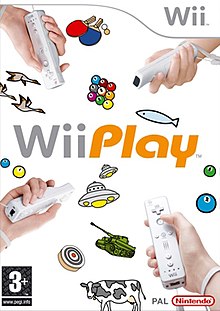
Mario Party is a party video game series featuring characters from the Mario franchise in which up to four local players or computer-controlled characters compete in a board game interspersed with minigames. The games are currently developed by NDcube and published by Nintendo, being previously developed by Hudson Soft. The series is known for its party game elements, including the often unpredictable multiplayer modes that allow play with up to four, and sometimes eight, human players or CPUs.
Super Smash Bros. is a crossover platform fighting game series published by Nintendo. The series was created by Masahiro Sakurai, who has directed every game in the series. The series is known for its unique gameplay objective which differs from that of traditional fighters, in that the aim is to increase damage counters and knock opponents off the stage instead of depleting life bars.

Mario Party 8 is a 2007 party video game developed by Hudson Soft and published by Nintendo for the Wii. It is the eighth main installment in the Mario Party series, as well as the first title in the series to be released for the Wii.

Wii Sports is a 2006 sports simulation video game developed and published by Nintendo for the Wii video game console. The game was released in North America along with the Wii on November 19, 2006, and in Japan, Australia, and Europe the following month. It was included as a pack-in game with the console in all territories except Japan, making it the first sports game included with the launch of a Nintendo system since Mario's Tennis for the Virtual Boy in 1995. The game was later released on its own as part of the Nintendo Selects collection of games.

WarioWare: Smooth Moves is a party video game developed by Nintendo SPD and Intelligent Systems. The game was published by Nintendo for its Wii video game system in Japan in December 2006, and in Europe, North America, and Australia in January 2007. It is the fifth game in the WarioWare series of games, and the only game in the series to be physically released for the Wii. Like its predecessors, WarioWare: Smooth Moves is built around a collection of microgames that last about five seconds each, and which require that the player hold the Wii Remote in specific positions. The game offers the microgames to the player in rapid succession, by first instructing the player to hold the Wii Remote in a specific manner, and then showing them the microgame. The microgames are divided into several stages, each of which loosely connects the microgames with the help of a story. Additionally, this was the first spin-off Mario game to be released for the console.

Wii Music is a music video game developed and published by Nintendo for the Wii video game console. The game was released in Japan and North America in October 2008, and in Europe and Australia in the following month. Wii Music is part of both Nintendo's Touch! Generations brand and the Wii series.
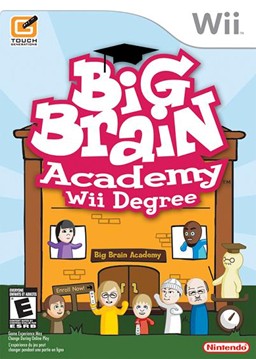
Big Brain Academy: Wii Degree, known in PAL regions as Big Brain Academy for Wii, is a video game released for the Wii. A sequel to the game Big Brain Academy for the Nintendo DS, it too measures a player's brain's weight, but with new games and puzzles to solve. The game makes use of Miis and uses WiiConnect24 features, allowing competition amongst users' friends, whose codes are automatically imported from the Wii's internal address book.

Mario & Sonic at the Olympic Games is a 2007 crossover sports and party game developed by the Sega Sports R&D Department. It is the first installment on the Mario & Sonic series. It was published by Nintendo in Japan and by Sega in other regions, and released on the Wii in November 2007 and the Nintendo DS handheld in January 2008. The first official video game of the 2008 Summer Olympic Games, it is licensed by the International Olympic Committee (IOC) through exclusive licensee International Sports Multimedia (ISM), and is the first official crossover game to feature characters from both the Mario and Sonic the Hedgehog series.
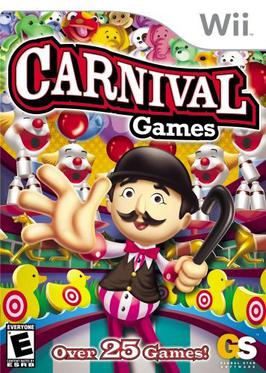
Carnival Games is a video game for Wii, Nintendo DS and iPhone, with a re-release for Nintendo Switch. It was the last game published by Global Star Software, before it was absorbed into Take-Two Interactive.

Mario Kart Wii is a 2008 kart racing game developed and published by Nintendo for the Wii. It is the sixth installment in the Mario Kart series, and was released in April 2008. Like its previous installments, Mario Kart Wii incorporates playable characters from the Mario series, who participate in races on 32 different race tracks using specialized items to hinder opponents or gain advantages. The game features multiple single-player and multiplayer game modes including two- to four-person split screen. Online multiplayer was supported until the discontinuation of Nintendo Wi-Fi Connection in May 2014. Mario Kart Wii uses the Wii Remote's motion-controls to provide intuitive and conventional steering controls. Each copy of the game was bundled with the Wii Wheel accessory to augment this feature and mimic a steering wheel.

Wii Fit is a 2007 exergaming video game designed by Nintendo's Hiroshi Matsunaga for the Wii home video game console, featuring a variety of yoga, strength training, aerobics, and balance mini-games for use with the Wii Balance Board peripheral. Matsunaga described the game as a "way to help get families exercising together". It has since been adopted by various health clubs around the world, and has previously been used for physiotherapy rehabilitation in children and in nursing homes to improve posture in the elderly.

Super Smash Bros. Brawl is a 2008 crossover fighting game developed by Sora Ltd. and Game Arts and published by Nintendo for the Wii. The third installment in the Super Smash Bros. series, it was announced at a pre-E3 2005 press conference by Nintendo president Satoru Iwata. Masahiro Sakurai, director of the previous two games in the series, assumed the role of director at Iwata's request. Game development began in October 2005 with a creative team that included members from several Nintendo and third-party development teams. After delays due to development problems, the game was released worldwide in 2008.
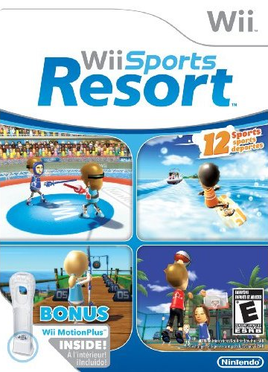
Wii Sports Resort is a 2009 sports simulation video game developed and published by Nintendo for the Wii video game console and is the sequel to Wii Sports. It is the first first-party Wii game to support the Wii MotionPlus accessory and the first one overall to require it, which was bundled with the game. Wii Sports Resort was first announced at E3 2008 and was released in Japan on June 25, 2009, and in nearly all other regions the following month. While Wii Sports Resort was first released as a stand-alone title, it was later bundled with newer Wii consoles alongside Wii Sports.

New Super Mario Bros. Wii is a 2009 platform game developed and published by Nintendo for the Wii. A follow-up to New Super Mario Bros., it was first released in Australia, North America, and Europe in November 2009, followed by Japan a month later. A high-definition port for the Nvidia Shield TV was released in China in December 2017. Like other side-scrolling Super Mario games, the player controls Mario as he travels eight worlds and fights Bowser's henchmen to rescue Princess Peach. New Super Mario Bros. Wii was the first Super Mario game to feature simultaneous cooperative multiplayer gameplay; up to four people can play in cooperative and competitive multiplayer modes, taking control of Mario as well as Luigi and one of two multicolored Toads. The game also introduced "Super Guide", which allows the player to watch a computer-controlled character complete a level.

Wii Party is a party video game developed by NDcube and published by Nintendo for the Wii video game console. The game heavily borrows game play elements from the Mario Party series, another Nintendo franchise. It is also the first game in the Wii series that Shigeru Miyamoto did not produce. The game was released in Japan on July 8, 2010, in North America on October 3, 2010, in Australia on October 7, 2010, and in Europe on October 8, 2010. Wii Party was revealed by Satoru Iwata in a Financial Results Briefing on May 7, 2010. It received mixed to positive reviews from critics and sold 9.35 million copies worldwide as of September 2021. A sequel, Wii Party U, was released for the Wii U on October 25, 2013.
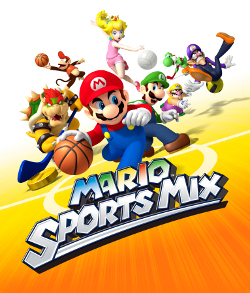
Mario Sports Mix is a sports video game developed by Square Enix and published by Nintendo for the Wii. It was released in Japan on November 25, 2010, and in other regions in early 2011. It features volleyball, ice hockey, dodgeball, and basketball. The game features mostly characters and locations from the Mario series with a few guest appearances by characters from Square Enix's Final Fantasy and Dragon Quest series of games. Players can also opt to play as one of their Mii characters.

Wii Play: Motion is a video game for the Wii console and the sequel to the 2006 game Wii Play. It was released in North America on June 13, 2011; Europe on June 24; Australia on June 30; and Japan on July 7, 2011.

Nintendo Land is a party video game developed and published by Nintendo as a pack-in launch title for the Wii U home video game console in 2012. The game was first announced at E3 2012 during Nintendo's press conference.

Wii Party U is a party video game developed and published by Nintendo for the Wii U in 2013. It was announced in a January 2013 Nintendo Direct, and later detailed at E3 2013 and the October 2013 Nintendo Direct. It is the sequel to the 2010 Wii game Wii Party.

Big Brain Academy is a series of puzzle video games developed and published by Nintendo. Similar to the Brain Age series, each game features a number of activities designed to test, measure, and improve the player's mental skills. The first two games were released under the Touch! Generations brand, which has since been discontinued.
